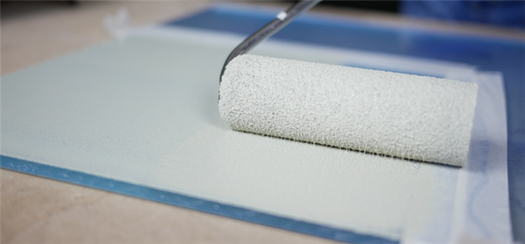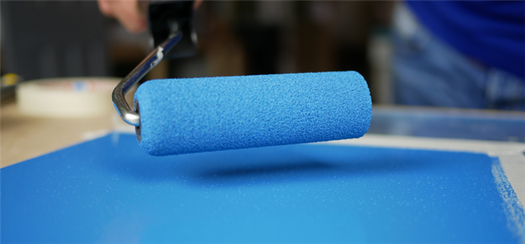Painting or staining PERSPEX® is not quite as straightforward as painting on wood, but you can paint acrylic glass with the right prepping. Painting on PERSPEX® is extremely popular among artists who use the plastic sheet as a ‘canvas’. There are endless possibilities: whether you want to create a PERSPEX® painting or paint a piece of plastic furniture, follow our six tips on how to spray paint plastic for a successful result.
How to Paint on Frosted Acrylic Plastic Panels
Throughout the ages, many of the greatest artists painted on unconventional surfaces. By straying from more basic materials like canvas, these artists made their pieces stand out with materials like stone, wood, and glass. Today, this same creativity persists among artists and DIY crafters with a new material – acrylic plastic, also known as plexiglass. With the right knowledge, painting on acrylic can create anything ranging from amazing three-dimensional art to eye-popping signs for an event.
However, the uninitiated sometimes dive in head-first without understanding how to paint plexiglass panels. The most common mistake is using the wrong type of paint or using a perfectly smooth sheet of acrylic. This can lead to a lot of heartbreak – an artist could spend hours painting the plexiglass sheet to then realize the paint is never going to fully adhere. To avoid these mishaps, let’s take a look at a few key recommendations for painting on acrylic panels.
Related Products



Why Paint on Frosted Plexiglass?
Frosted plexiglass and P95 acrylic are some of the most commonly used types of acrylic for painting. This isn’t just for aesthetic reasons – frosted and P95 acrylic have a light matte finish that gives paint the “tooth” that it needs to stick to acrylic. Tooth is extremely important – it’s one of the reasons why many artists reach for a bumpy canvas instead of a smooth sheet of paper. In the same way, smooth sheets of acrylic are slick, which can interfere with adherence and make the paint easier to scrape off.

P95 and frosted acrylic have a couple of important differences that painters and DIYers should consider before choosing their surface. Let’s take a closer look at what this difference means for you:
-
Frosted Plexiglass – Frosted plexiglass has a matte finish on both sides of the plastic, which creates a frosted appearance. This means that paint will stick effectively to both sides of the acrylic sheet. However, its aesthetic appearance is a far cry from a smooth sheet of acrylic plastic – it is not recommended for multi-layered or reversible pieces of art.
However, maybe you’re not keen on using a matte finish at all. If this is the case, then think ahead and pick up some fine-grit sandpaper, and plan out what you’d like to paint. Use the sandpaper to lightly scuff the area that will be painted. This will help the paint stick significantly better while keeping a rather clear appearance.
Alternatively, you can paint directly on top of a sheet of plastic, then carefully place another sheet of plastic on top of the dry painted sheet as a form of protection. If you choose this method of framing, make sure that the frame and plastic inside are well-supported, and not bending at all. For the highest level of optical clarity, we recommend using frame-grade acrylic sheets.
Prepare the Plexiglass
Once you select the right kind of plexiglass for your art piece or project, it’s time to prepare the plexiglass sheet for painting. First, clean the acrylic using either a mixture of water and dish soap or a specialty cleaning product like Novus #1. Gently wipe any excess material off the sheet using a clean, soft cloth.
For the best adhesion properties, use an acrylic-based primer – you can commonly find these as cans of spray paint at craft or home improvement stores. To avoid inhaling fumes, only spray the primer outdoors or in a very well-ventilated room. Keep in mind that acrylic primer can damage furniture, so it’s recommended to lay down newspaper or a tarp before you begin spraying. When spraying the primer, hold it about two feet away from the acrylic sheet and try to spray the surface as evenly as possible. Once the primer has dried, the sheet will be ready for painting.
# 1. Painting on cast or extruded acrylic
If you plan to paint on acrylic or use it as a canvas and also want to saw or drill the sheet, we advise not using extruded (XT) acrylic but opting for the cast version (GS) instead. Cast acrylic is more suitable for processing than the extruded type. The difference lies in the production process – with extruded acrylic, there is more tension on the sheet. The tension makes this type of acrylic more likely to break and, therefore, more difficult to process.
The best way to prepare your acrylic will depend on what you want to make and how intensively you will be using the application. For example, making a painting on PERSPEX® requires a different approach than when you intend painting or spraying all over a set of plastic furniture.
Preparing PERSPEX® for making a PERSPEX® painting:
- Degrease the PERSPEX® canvas using lukewarm soapy water, an anti-static cleaner and a soft, lint-free cloth.
- Rinse the sheet well with lukewarm water.
- Check that the plastic sheet is free of dirt or you might scratch it when drying.
- Dry the PERSPEX® canvas with a soft tea towel.
Preparing PERSPEX® when you want to give an entire sheet a solid colour:
- Lightly roughen the surface to be painted by sanding with grit 220 or abrasive wool such as Scotchbrite.
- Degrease the PERSPEX® with lukewarm soapy water and an anti-static cleaner.
- Check that the plastic sheet is free of dirt or you might scratch it when drying.
- Dry the sheet surface with a soft dish towel.
- (Optional) if your plastic sheet isn’t too large, place in an oven at 40 ° Celsius for 10 minutes. This procedure will dry it thoroughly. The temperature also helps the primer and paint to adhere.

# 3. Avoid solvents if you are going to paint PERSPEX®
PERSPEX® is sensitive to solvents, and solvent-based paint will cause the sheet surface to soften and distort. The paint may subsequently react with the PERSPEX®, resulting in very disappointing results.
If you want to paint acrylic in a solid colour, two options will each give you a good result: a water-based paint on latex base or acrylic lacquer. Be sure to use a good primer that is suitable for plastic. The primer ensures that the paint adheres to the surface and doesn’t flake or peel. Alternatively, use an acrylic lacquer, which you can see in the photos below. Always read the packaging carefully or ask the seller whether the paint is suitable for plastic surfaces. You can apply the paint with a brush or roller, with a roller giving a better finish. If you’re going to spray the paint, keep an eye on the recommended spraying distance and ambient temperatures. Spray in several (3-4) thin coats.


Are you going to make a painting on PERSPEX®? Acrylic or oil paints are the media most commonly used, and you don’t need to use a primer with them, as long as you have degreased your canvas thoroughly. Painting on smooth materials, such as PERSPEX®, is more complicated than painting on canvas. The paint moves more easily, which isn’t always what you want. Using soft brushes will make the paint less streaky.
# 5. Use good quality masking tape for masking
If you want to mask part of the sheet, choose a good quality painter’s tape. It’s worth spending a bit extra on this. Good painter’s tape provides a straight masking line and leaves no glue residue on the PERSPEX® sheet. Removing adhesive residue can be a time-consuming job, which you can easily avoid.
After spraying or painting, wait until the surface is bone dry. Have you masked an area of it? Remove the tape before the paint has cured because it will still yield along the edges. You get a nice straight line when removing the tape and you won’t pull the paint away with it. Then allow the paint to dry and harden properly. Always adhere to the drying time stated on the paint packaging.
If you used spray paint, we recommend that you finish with a polyurethane-based clear topcoat. This protects the paint layer and gives a better result.





